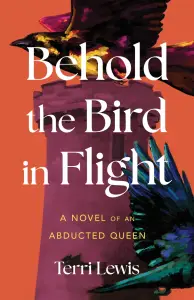Hear the Conversation | Get the Book

In the crowded court of historical fiction, it’s rare for a debut novel to feel both freshly imagined and rigorously grounded, but Behold the Bird in Flight, the first novel from Terri Lewis, manages to do just that. With poetic grace and cinematic clarity, Lewis resurrects Isabelle d’Angoulême—a nearly forgotten queen whose life was anything but minor. Abducted by King John of England while engaged to another, the young French noblewoman becomes, in Lewis’s hands, a fully formed human being: observant, ambitious, and perpetually negotiating the limits of her power in a patriarchal world.
It is no surprise that Lewis—whose own story could be mistaken for fiction—has made a literary debut so striking. A former ballerina who once graced European opera stages, and now a novelist who has studied with luminaries like Rebecca Makkai and Laura van den Berg, Lewis brings a hybrid of artistic rigor and emotional precision to the page. Her past lives inform not only her discipline but her sensitivity to embodiment—how a woman moves through space, both physically and historically.
“I discovered her in two sentences,” Lewis recalls of Isabelle, her tone tinged with the kind of fate-driven wonder that animates fairy tales. The setting? A gift shop in Windsor Castle. The text? A history book with a fleeting reference to a queen kidnapped from her fiancé by a lustful English king. “I just couldn’t let go of it,” she says. “It took me by the neck.”
What began as a spark of curiosity led Lewis into the archives—literal and emotional—of the medieval world. Unlike many historical novelists who rely on secondary texts, Lewis’s first real exposure to the period came from a college professor who insisted students read original documents: excommunications, grants, arrest warrants. “He showed me there was more to the medieval world than you get in high school,” she says. That sense of immediacy—of reading history not as a textbook but as a living, breathing texture—would become a central tenet of her novelistic approach.
Lewis writes Isabelle not as a legend, but as a girl. A twelve-year-old girl, in fact, because in the 13th century, that’s when womanhood began. When Isabelle first lays eyes on King John, she doesn’t see a sovereign or a monster. She sees a man with a hole in his hose. “She noticed that detail,” Lewis says, almost with delight. “Not that he was spectacular.” That grounding in the mundane—small observations, awkward silences, moments of internal conflict—strips away the gauzy romanticism that so often enshrouds royal figures. In its place is a perspective both intimate and jarringly modern.
Yet Lewis resists the urge to overlay contemporary sensibilities onto the past. Her language is carefully curated, avoiding anachronism while remaining accessible. She eschews contractions in dialogue but allows them in narrative. Many verbs, she explains, were researched for historical authenticity. Even mild expletives had to earn their place. Referring to a moment when Isabelle utters a surprisingly candid exclamation, pismire, she says, “I thought that was a perfect word for a little girl growing up,”
This insistence on precision—the same kind that once kept her muscles taut in pliés and arabesques—translates into a prose that is both lyrical and scrupulous. “It takes ten years to learn an art form so that you can express your own feelings,” Lewis notes. “It took that long in dance. And it took that long in writing.”
Her literary formation was not undertaken alone. Inspired by the works of Rebecca Makkai, Lewis approached her at a reading with the kind of humility that only true admirers possess. That encounter led to a special workshop. Later, she joined the Lighthouse Writers in Denver, where she studied with Laura van den Berg . “She gave me confidence,” Lewis says simply.
Confidence and perhaps a measure of boldness. One of the more startling historical facts Lewis unearthed—and chose not to soften—was Isabelle’s decision to leave her children behind in England when she returned to France. To modern readers, this might seem cruel or callous. But Lewis invites us to see the act in context. Royal children were often raised apart from their mothers. And Isabelle’s departure, rather than a dereliction, reads as a reclamation. A woman extricating herself from a life that was not truly hers.
The novel’s historical fidelity did not go unnoticed. Sharon Connolly Bennett, a Royal Historical Society member and expert in medieval royalty, called it “an astonishing recreation.” For a debut novelist, such praise might seem like a coronation in its own right.
But Lewis remains grounded in the work. Her next book recently won the Miami University Press 2025 Novella Prize. She’s already deep into other projects. And at the core of it all is not ambition, but necessity. “It’s just like dancing,” she says. “I have to write.”
With Behold the Bird in Flight, Terri Lewis offers readers more than a captivating story. She offers a re-encounter with the past—a way to see, feel, and recognize ourselves in lives once thought foreign. She invites us not only to behold Isabelle d’Angoulême, but to listen to her. To stand, for once, not in the shadows of kings, but in the presence of a woman who knew her own mind, her own limits, and her own worth.
In doing so, Terri Lewis accomplishes something rare: she turns history into revelation.
Learn more at TerriLewis1.com.Terri Lewis – Behold the Bird in Flight: A Novel of an Abducted Queen

